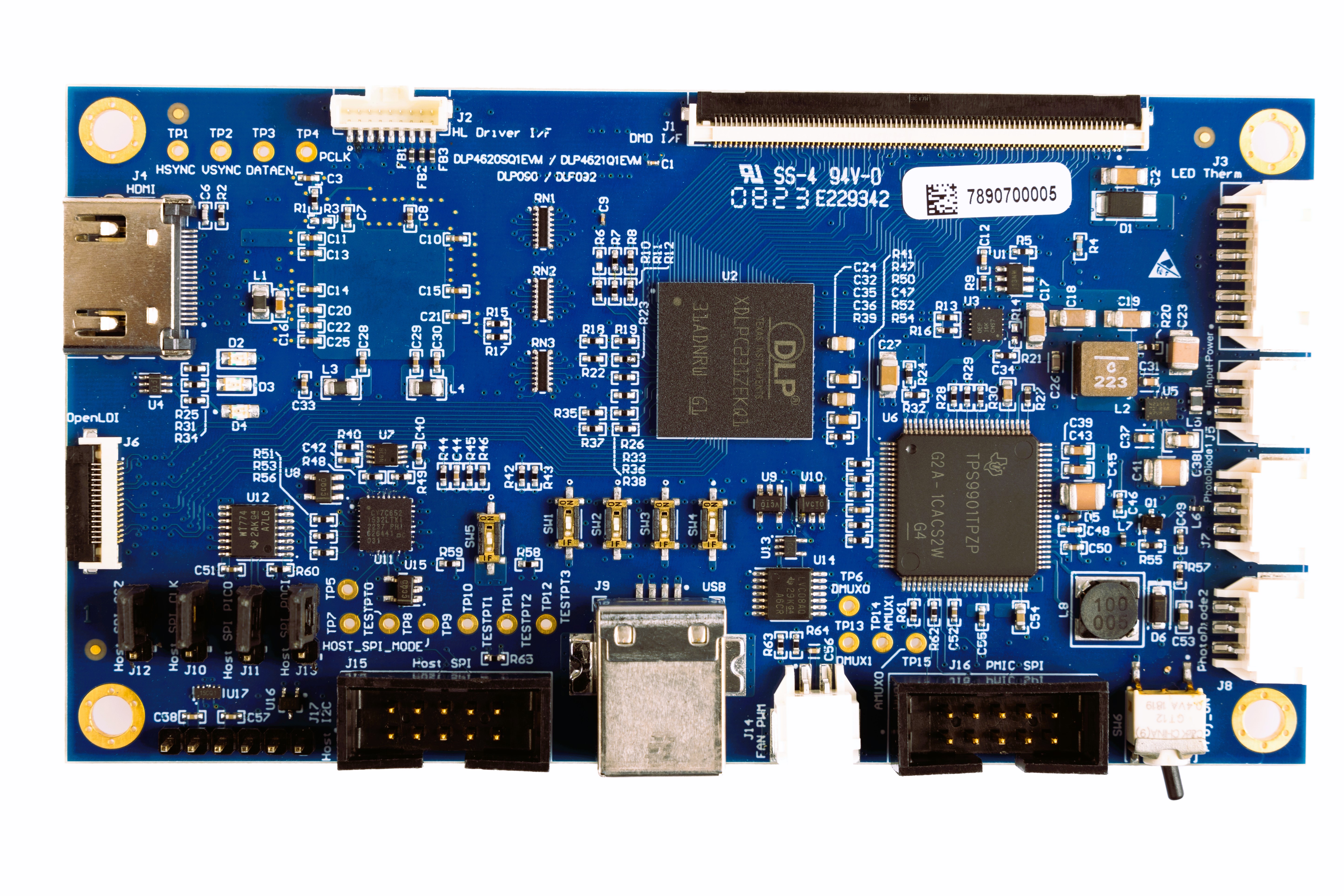DLPU137 April 2024
- 1
- Description
- Features
- Applications
- 5
- 1Evaluation Module Overview
- 2Hardware
- 3Software
- 4Hardware Design Files
- 5Additional Information
2.3 Controller PCB
The controller PCB shown in Figure 3-3 includes the DLPC231-Q1 DMD Controller and the TPS99001-Q1. The controller PCB supports video inputs from either a HDMI or OpenLDI interface and provides the formatting and control to display the video on the DLP4620S-Q1 and DLP4621-Q1 DMDs.
The controller board has a SPI port for users who wish to use a Cheetah™ SPI host adapter. However, the Cheetah host adapter must be bought separately from the EVM. This port allows for high-speed SPI communication between the controller board and host. An optional second SPI port is provided for monitoring the TPS990001-Q1 or the TPS99000S-Q1.
The controller board has an additional I2C port. The provided I2C cable includes PROJ_ON, HOLD_BOOT, and HOST_IRQ, signals readily available to allow indirect control and monitoring of the EVM.
If direct SPI or I2C is not preferred, there is an on-board Cypress chip that allows for USB to SPI or USB to I2C communication.
Each of these communication ports allow the user to communicate to the controller from the external world via a PC or the Automotive Control Program reference software, which speeds up the development of supported automotive EVMs. Some features include flashing new firmware onto the controller, changing test pattern generator (TPG) images, changing sources (such as TPG to HDMI), or obtaining controller or PMIC (TPS99000-Q1) diagnostics.
The controller board has an external photodiode input that is used to control white point and brightness over a wide dimming range. An optional second photodiode input is also provided for the DLP4620SQ1EVM kit.
The LED thermistor on the board can be used to measure the temperatures of the red, green, and blue LEDs when using the DLP4620SQ1EVM.
The headlight interface port helps control the LED brightness and PWM output from the controller for the DLP4621Q1EVM.
On the opposite side of the EVM is a HUD interface port, which helps control and monitor an illumination design such as the RGB LED driver provided in the kit. This is used for the DLP4620SQ1EVM.
 Figure 2-3 DLPC231SQ1EVM Controller
PCB
Figure 2-3 DLPC231SQ1EVM Controller
PCBThe controller PCB contains the ports listed in Table 3-1. Indicator LEDs are listed in Table 3-2.
| SCHEMATIC REFERENCE | FUNCTION |
|---|---|
| J1 | DMD flex cable interface |
| J2 | Headlight driver interface |
| J3 | LED thermistor |
| J4 | HDMI input |
| J5 | Driver controller power |
| J6 | OpenLDI input |
| J7 | Photodiode 1 |
| J8 | Photodiode 2 |
| J9 | USB Input |
| J10 | Host 1/2 SPI_CLK select |
| J11 | Host 1/2 SPI_PICO select(1) |
| J12 | Host 1/2 SPI_CSZ select |
| J13 | Host 1/2 SPI_POCI select(1) |
| J14 | Fan PWM output |
| J15 | Host SPI |
| J16 | PMIC SPI |
| SCHEMATIC REFERENCE | FUNCTION |
|---|---|
| D2 (Green) | PROJ_ON Off: System Off On: System On |
| D3 (Green) | Input power to
controller (from LED driver) Off: No power connected On: Power connected |
| D4 (Red) | HOST_IRQ Off: Interrupt not asserted On: Interrupt asserted |
The controller PCB switches are listed in Table 3-3. SW4 is a toggle switch for PROJ_ON, which is used to turn on and off the electronics. Note that parts of the board are still powered when PROJ_ON is in the off position. SW1, SW2 and SW3 are dip switches that control the states of configuration signals the DLPC230-Q1 reads when the DLPC230-Q1 comes out of reset. These switches must be set based on the desired configuration options.
| SCHEMATIC REFERENCE / SIGNAL NUMBER | FUNCTION |
|---|---|
| SW1 | CHKSUM_SEL Off: Disabled On: Enabled |
| SW2 | HOST_IF_SEL
Off: CRC On: Checksum |
| SW3 | HOST_SPI_MODE
Off: Host SPI On: Host I2C |
| SW4 | SPREAD SPECTRUM ENABLE Off: Mode 0 or 3 On: Mode 1 or 2 |
| SW5 | HOLD_BOOTZ Off: Do not hold in boot (continue to main application) On: Hold in boot |
| SW6 | PROJ_ON Off: Turn off system On: Turn on system |